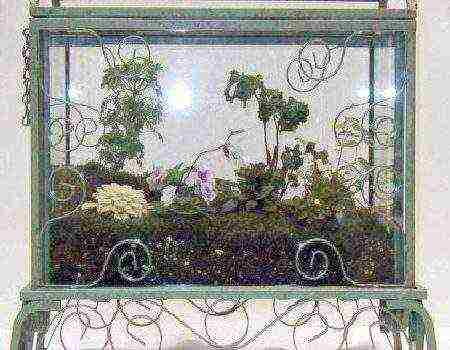Content
Many species of honeysuckle are very often cultivated in gardens as beautiful ornamental shrubs, well suited for groups, alleys and arbors; Russian species bloom in early summer, that is, in late May to mid-June. We will talk with you about Honeysuckle blue (Lonicera caerulea), which has many names, but is more often called Edible honeysuckle.
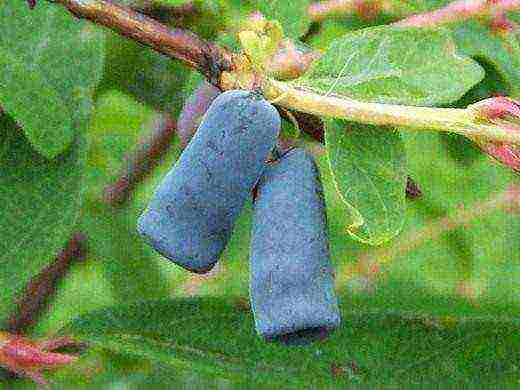 Blue honeysuckle berries
Blue honeysuckle berries
Honeysuckle is an upright, highly branched shrub up to 2 m high with brown scaly bark and pubescent oblong leaves. Already in early May, beautiful yellow flowers appear on the bushes, attracting insects with their aroma. Flowering is extended in time for a whole month, which allows the bulk of flowers to avoid frost damage and ensures a stable annual yield. The berries are dark purple with a bluish bloom, have a thick coloring juice, which is reminiscent of blueberries, but their sizes and shapes on the bush are different, as a rule, the shape is oblong. The taste of the berries is sweet and sour, depending on the degree of ripeness.
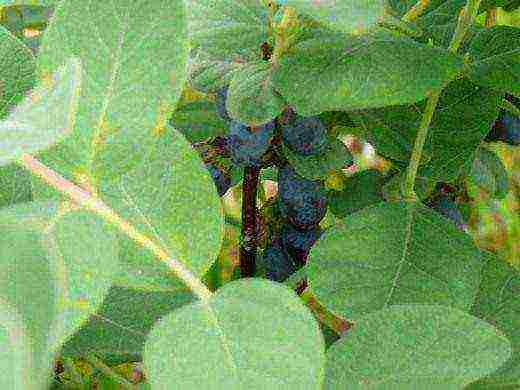 Blue honeysuckle berries
Blue honeysuckle berries
Planting honeysuckle
For edible honeysuckle, choose an open and sunny place, but protected from the wind. It is convenient to plant bushes along the edge of the plot with a distance between plants from 0.5 (dense hedge) to 1.5 m. The soil should be moisture-absorbing, but without stagnant water. Almost any type of soil.
It is better to plant honeysuckle in the fall. Plants planted in spring take root worse, and besides, this should be done early - in April, before flowering.
Most varieties are self-fertile; to ensure cross-pollination, you will need at least two different varieties blooming at the same time, and preferably three to five. Planting material (2–3 year old seedlings) should look like this: the aerial part consists of 4–5 skeletal shoots 25–35 cm long and at least 5 mm thick at the base, roots not shorter than 25 cm, with 4–5 branches.
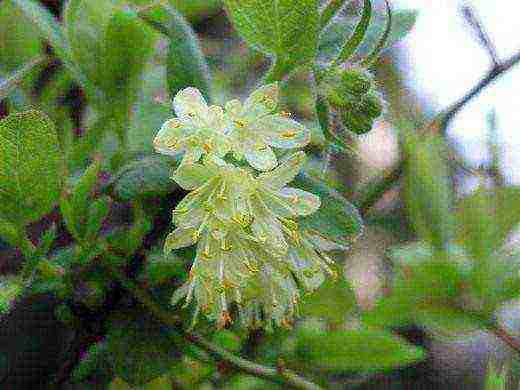 Blooming Honeysuckle blue, edible
Blooming Honeysuckle blue, edible
Immediately before planting, planting pits are prepared (40x50x40 cm). Organic fertilizers are introduced into them (up to two buckets, depending on the type of soil), as well as superphosphate (up to 200 g) and potassium salt (35–40 g).
Requirements for growing honeysuckle
Location: bushes bloom and grow better in lighted places and in partial shade. They bloom weakly with strong shading. Most honeysuckles, especially the climbing species, are light-requiring and prefer open, sunny areas. However, forest species can tolerate light shade and will thrive in a canopy garden. In such conditions, higher air humidity remains, which is especially important for these plants.
The soil: Honeysuckle grows well on any soil, but develops better on loose and drained soil. Too dry areas, as well as closed basins, are considered unsuitable for planting. The soil mixture consists of turf, humus or peat and sand, taken in a ratio of 3: 1: 1. The optimum soil acidity is 7.5 - 8.5. On heavy damp soils, as well as on poor sandy soils, honeysuckle grows poorly. Drainage from broken brick or gravel is required with a layer of 5-7 cm.
Preparing for winter: no special preparation for overwintering is required. Only sometimes the ends of the shoots are slightly damaged by frost, which does not reduce the decorative effect of the plants.
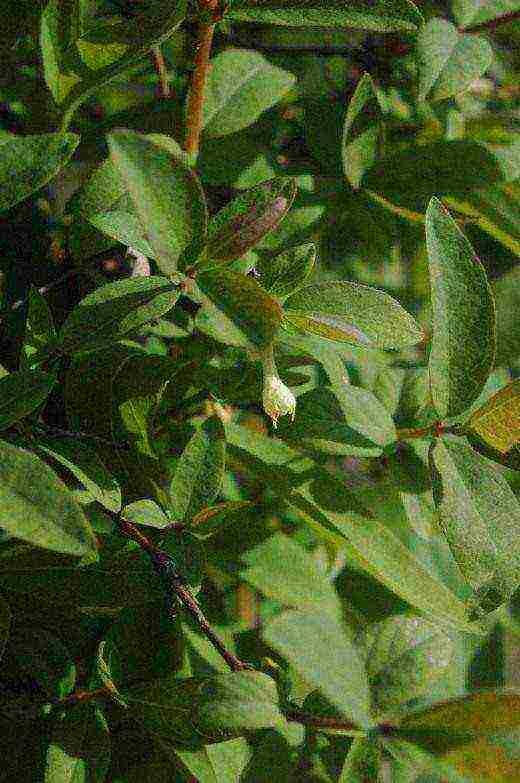 Blue honeysuckle, berry
Blue honeysuckle, berry
Honeysuckle care
In the first 3-4 years after planting, honeysuckle grows slowly. At this time, you only need to weed and loosen the soil - but do this carefully, since the plant has a superficial root system. It is better to immediately mulch the root circle with humus, peat or dry soil. Thanks to this, moisture will also be preserved, especially necessary for honeysuckle in the first half of summer, during the intensive growth of shoots. With insufficient watering, even dessert varieties will taste bitter.
From the age of 6-8, the plants are pruned, removing old and damaged branches under the base. In order for the crown not to become too thick, they get rid of numerous root shoots. The tops of young shoots, which have the maximum number of flower buds, are not cut off.
In autumn, honeysuckle is fed with phosphorus and potassium fertilizers - up to 30 g of superphosphate and up to 20 g of potassium salt per 1 sq. m. In the spring, you can apply nitrogen fertilizers (30 g of urea for the same area).
The first fruits of early varieties of honeysuckle appear at the end of May, and mass ripening occurs in six to seven days. It is quite extended, and it is better not to postpone the collection, since in most varieties the berries fall off easily.
Saplings begin to bear fruit already in the second or third year after planting, the maximum number of berries is given in the fourth or fifth year. With good care, honeysuckle can produce high yields for 20–25 years.
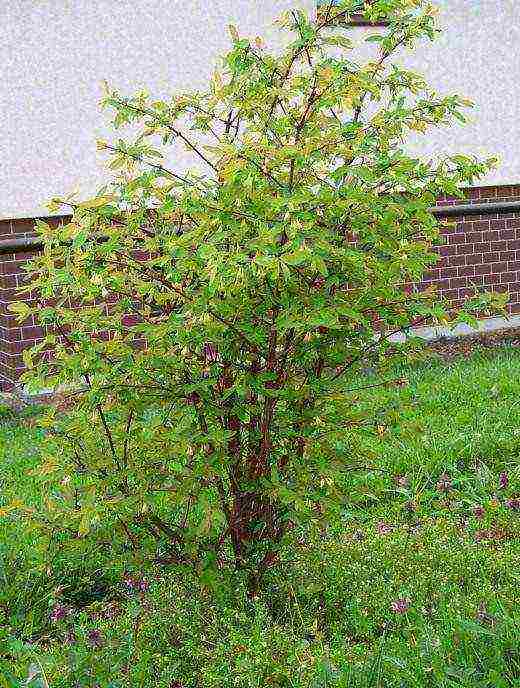 Blue honeysuckle bush
Blue honeysuckle bush
Reproduction of honeysuckle
Honeysuckle can be propagated by seed and vegetative methods.
The most effective method green cuttings... After flowering or during the period when the first fruits appear from strong annual shoots of the current year, cuttings are cut using the middle part of the shoot. A cutting 8–12 cm long should have two or three buds and a couple of leaflets at the crown. Cut cuttings are treated with growth stimulants. The soil mixture is prepared from peat and sand in a ratio of 1: 3. Cuttings are planted obliquely according to the 5x5 cm scheme in ordinary garden greenhouses or greenhouses. In them it is necessary to maintain the optimum humidity of the substrate and air (up to 85%) and a temperature of 20–25 ° С. To reduce moisture evaporation, the film is shaded with burlap. Under such conditions, after two to two and a half weeks, the cuttings develop a root system, and by the beginning of September it will be fully formed and then they can be planted for growing in a garden bed.
Young plants, branches of which are located close to the ground, are convenient to propagate horizontal layering... In late April - early May, annual shoots are bent to the ground and pinched at their top, then spud with moist earth or humus. And during the growing season, they keep the soil moist. By the fall, the roots are formed at the layers - the plants are separated and transplanted.
You can also use and dividing a bush... In early spring or autumn, after the end of leaf fall, 3-5-year-old bushes with a loose crown are dug up and divided into two or three parts
Diseases and pests
Honeysuckle aphid
When a honeysuckle-cereal aphid appears on young shoots, the leaves turn yellow completely or in spots, or curl across or obliquely. Lemon-yellow larvae migrate to cereals, and in the fall they return and lay hibernating eggs. From the honeysuckle apical aphid, the apical leaves bend in half, twist and die, the growth of shoots stops.
In the summer they are sprayed with infusions of garlic, tobacco, pepper. Early spring treatments with 0.2% actellik, rogor, confidor, preparations "Aktara", "Eleksar" are more effective.
Honeysuckle mite
Ticks thrive in wet conditions, especially in thickened and shaded plantings. Honeysuckle is affected by several types of mites.If dark shapeless "blots" appear on the underside of the leaves, and at the end of summer all the leaves on the bush turn brown, dry out and curl, then this is caused by the appearance of microscopic honeysuckle rinkaphytoptus.
From damage by a honeysuckle mite, the edges of the leaves become corrugated, the leaves fall off prematurely. In plants weakened by a mite, the upper side of the leaves is covered with sooty fungi in the form of a black bloom. It is useful to thin out thickened plantings, treatment with acaricides (Omite, Tedion, Mauritius), and at the end of June with a 0.257th actellik, a rotor, and a confidor.
Shield
These small pests, covered with a shield on top, attach tightly to the bark and suck the juice from the branches and shoots. Acacia pseudo-scale, apple comma-shaped scale, willow scale are ubiquitous and can cause death of plants. Fighting - double spraying of honeysuckle bushes in late June - July with an interval of 10-15 days with rogor or actellik. The branches on which the scabbard settled at an air temperature above 0 ° C can be doused with kerosene.
Leaf-eating pests
Several species of insects feed on honeysuckle leaves, without causing serious damage, but reducing the decorative effect of shrubs. The caterpillar of the honeysuckle striped sawfly eats holes of various shapes. The caterpillars roughly eat away the tissue of the leaf blade; only the petiole and large veins are not touched. Since pests on honeysuckle are few in number, they are eliminated mechanically by picking them up by hand. If twisted leaves appear on the growing shoots at the beginning of summer, this is the result of the vital activity of a currant or rose leaf roll. Narrow long passages are made by the larvae of the honeysuckle miner and the honeysuckle moth. Sawflies, moths, and herbivorous bugs settle on the leaves. During the period of mass appearance of pests, 0.05% decis, Inta-Vir and Eleksar preparations are used.
Honeysuckle fingerwing
Honeysuckle fingerfly caterpillar feeds on fruit pulp and seeds. Because of it, unripe fruits darken, shrivel and crumble. The drug "Inta-Vir", infusions of tomato and potato tops.
Honeysuckle with edible fruits should not be sprayed with pesticides in early June, until the harvest is fully harvested.
Fungal diseases
With high air humidity, optimal conditions are created for the appearance of various spots on the leaves of honeysuckle, from which they are deformed and gradually dry out. With ramulariasis, brown spots are visible; cercosporosis - rounded brown spots that fade over time. In some years, powdery mildew is found with a characteristic whitish bloom, especially on the underside of the leaves. Early spring spraying of bushes with 0.2% fundozol, copper-soap liquid (100 g of copper sulfate per 10 liters of water). Powdery mildew - Topaz preparation, 0.57 solution of soda ash, pollination with colloidal sulfur or wood ash.
Phytoviruses
Potato and cucumber mosaic viruses, widespread in many crops, can infect honeysuckle in some years. Light green spots and mottling appear on the leaves along the central veins. In some edible cultivars, as yet in isolated cases, a mosaic virus has been registered with a characteristic yellow-white mosaic pattern on the leaf.
Maintaining a high level of agricultural technology and the acquisition of healthy planting material are the main control measures. The infected bushes are dug up and burned.
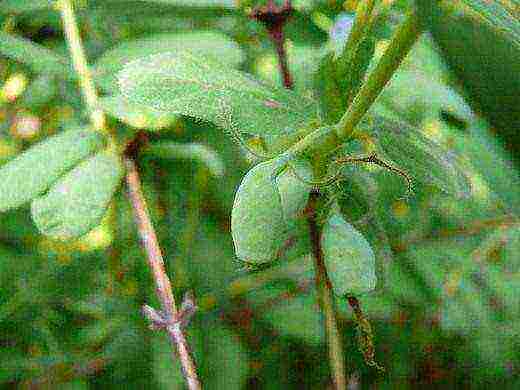 Unripe berries of blue honeysuckle
Unripe berries of blue honeysuckle
About 180 species of honeysuckle are known in almost all areas of the northern hemisphere, but mostly in the Himalayas and East Asia.
Not everyone knows that honeysuckle is the most valuable medicinal plant!
Edible fruits are rich in vitamins. They have a beneficial effect on the cardiovascular system, have anti-inflammatory, diuretic, choleretic and anti-ulcer effects.
The most favorable time for planting this wonderful shrub is mid - end of September.Honeysuckle is able to adapt to a wide variety of conditions. Nevertheless, in order for it to produce high yields, it is advisable to create good conditions for it. This plant requires sufficient soil moisture, but at the same time does not tolerate waterlogged areas at all, where the groundwater level is above 1 m.It reacts to the dryness of the soil and air by reducing the number of buds laid and the size of fruits, the taste of which deteriorates.
Honeysuckle is a light-loving plant. When planted in the shade, it gives small growths and does not bloom well. If the soil is clayey and water stagnates in it, then drainage is indispensable. It can be made of gravel, stones, broken bricks at a depth of 0.7 m. They are poured 10-15 cm thick onto a leveled subsoil and tamped well. A layer of coarse sand 10 cm thick is poured on top, which is also compacted.
A planting hole for 2-3-year-old bushes with a depth of 25 cm and a diameter of 50 cm is prepared in advance. Heavy clay soil is dug up to improve its structure, and sand and peat are added for greater porosity (10-15 kg per 1 m2). In the sandy soil, loam and peat are introduced (4-5 kg per 1 m2). Peat promotes water storage and retention. 10 kg of well-rotted compost, 15 g of super-phosphate and 70 g of potassium fertilizer are added to each planting pit. Fertilizers are thoroughly mixed with a fertile soil layer, digging it to a depth of 22-25 cm. If the soil is very acidic, it is recommended to apply 100-200 g of lime per 1 m2.
Better, of course, to plant a seedling with a closed root system. The root collar must be located at the level of the soil layer. Then the earth is compacted and the seedling is well watered.
Adults, already fruiting honeysuckle bushes are transplanted in the fall. In a new place, holes are dug for them at least 70 x 70 cm in size, 50 cm deep, filling them with organic and mineral fertilizers.
Bushes older than 6 years are pruned at a height of 40-50 cm before planting in order to create a balance between the aboveground part of the bush and the root system. However, such plants take a long time to take root.
Tatiana PROKOPENKO
Volgograd region
 CULTIVATION OF EDIBLE HONEY
CULTIVATION OF EDIBLE HONEY
The cultivation of edible honeysuckle in Russia began only in the XX century. Despite this, the varieties obtained, and for each locality they have their own, are recognized as the best. Now the cultivation of honeysuckle is becoming more and more popular, because the culture is unpretentious and useful.
HARVEST: PLANTING A SEEDLING
As soon as the average daily temperature becomes positive, the honeysuckle buds immediately wake up. Therefore, planting a seedling in the spring is permissible only in late April - early May. In the fall, you can plant honeysuckle starting in mid-September. An ideal seedling should have not one, but several shoots with a diameter of at least half a centimeter each and branched roots by a quarter of a meter or more.
A self-infertile plant, edible honeysuckle, definitely needs a pollinator. Planting honeysuckle of different varieties or shapes (at least three) solves the problem. If you want to have berries of a sweet and sour taste, plant varieties of only this property, it will be preserved in all bushes. If you are a gourmet, combine any varieties of simultaneous flowering, then the possible presence of a light bitterness in the berries will suit your taste - some varieties have such a feature and are capable of transferring their properties when cross-pollinated.
The honeysuckle planting site is chosen carefully; this shrub can live for almost a quarter of a century. The most suitable place is open, which may have light partial shade. In places with high groundwater, honeysuckle does not grow, there planting is carried out on ramparts or mounds, taking into account that the deepest roots penetrate 80 cm into the ground.Planting honeysuckle in a row or along the perimeter of a rectangle is not at all a prerequisite for growing. The berry shrub looks good in landscape compositions with woody or ornamental herbaceous plants.With a dense planting pattern, honeysuckle can act as a hedge. Separately planted undersized varieties will look good among stones.
The roots of the shrub extend far horizontally, in an adult plant up to 3 meters from the center, so a wide and shallow planting hole is prepared. Its diameter is at least 50 cm, its depth is 30 cm, 1 m or more must be left between the plants. It depends on the size of the future bush (variety). Honeysuckle develops very slowly and loves cultivated soil with good organic matter, without weeds with superficial roots. Weeds are aggressive and young seedlings will not grow well in their neighborhood, which is why grooming is so important. Honeysuckle is weeded or mulch the soil underneath. In the first three years, honeysuckle forms a root system, only then active growth and fruiting begins. The maximum yield of honeysuckle gives at the age of 17 years.
Honeysuckle is planted in a pit filled with rotted manure, humus or compost, mineral fertilizers (PK) are added. Mix everything well. Damaged branches and roots are removed before planting. A pile of earth is formed inside the pit, on which the roots of the seedling are spread. The root collar is positioned so that it is sprinkled with 5 cm of soil on top. Having covered the roots with nutritious soil, they form a planting hole with sides, into which the shrub is watered. When the water is absorbed, 5 cm thick mulch is placed on top - humus, peat, cut grass. After planting, the honeysuckle is monitored especially carefully: watered, shaded from the bright sun, weeded. Before the snow, the seedling manages to take root well and hibernates without shelter.
HONEY: CARE AND FEEDING
Care in spring and early summer, when shoots are growing and berries ripen, is especially important. Honeysuckle needs moisture, but it should not be too much, otherwise the fruits will be large, but watery. Mulching facilitates care and improves the quality of berries, it will not allow the plant to overflow and retain moisture from evaporation.
Good care and feeding are inseparable things. In the early years, honeysuckle is fed with slurry, and nitrogen fertilizers are applied in the spring. Potassium and phosphorus can be used in the fall or spring. It is advisable to sprinkle humus under the bush every year, water it with infused ash during flowering, and after harvesting with fermented weeds (green fertilizer). Such feeding has a positive effect on the taste of the berries.
So that caring for honeysuckle is not in vain, the harvest is harvested on time. Many varieties are characterized by uneven ripening, after which the fruits crumble. The best way to preserve the harvest is to spread a matting under the bush and shake the branches - the ripe berries will fall off by themselves. In varieties with nonshattering berries, the collection is carried out by hand, allowing them to ripen longer on the branches.
In caring for honeysuckle, proper pruning of the bush is important; it is carried out in early spring. In the year of planting, at least 2 and no more than 5 well-developed shoots are left, weak ones are cut out. The upper part of the shoots is cut off for better tillering, in the future this should not be done, since there are flower buds on the tops, that is, the future harvest. In the first decade, only sanitary pruning of honeysuckle is carried out. Then the broken and dried branches are cut out. Then every year or three - thinning pruning: branches with weak growth and thickening are cut from the center of the bush.
Like currants, the bush should have branches of different ages. BLACK CURRANT TRIMMING To rejuvenate the bush, the branches are greatly shortened. For a very old bush, pruning branches to ground level is used. Young shoots will completely restore honeysuckle in three years. The diagram shows the pruning of honeysuckle in the year of planting, in the second year, in the third year.
Honeysuckle is propagated by cuttings, layering and seeds. They mainly use vegetative propagation, it retains the varietal characteristics of the plant, and the bushes begin to bear fruit faster.
Honeysuckle: reproduction by layering
Honeysuckle propagation by layering is the best way, especially for varieties with large fruits. It is carried out like reproduction of currants... In the spring, annual shoots are pinned into shallow grooves. You can cover the entire shoot with soil, leaving the top, or cover only its middle part. The top will need to be tied to a vertical peg so that it grows evenly. New shoots will also appear from the covered buds during the summer. They need to be watered and do not forget to add earth, because the delicate roots should not dry out. In autumn (or spring), young plants are separated from the bush with pruning shears and transplanted to a permanent place or for growing.
Honeysuckle: propagation by cuttings, green cuttings
Honeysuckle propagation by cuttings is carried out in different ways: green or lignified. Green cuttings are cut in May. After flowering, the tops of the green shoots are cut off and placed in water. Do it in the morning. The cutting should have two internodes. The leaves on the crown are shortened by half, the lower ones are removed. If you are cutting a branch of an unknown variety, remember that the larger the honeysuckle leaf, the larger the berry will be.
Stepping back slightly from the lower kidney, make an oblique cut with a blade. Roots will go from this bud in the ground. Cuttings are planted in the greenhouse at an angle, half immersed in the soil. The distance between the cuttings is 7 cm.
The top layer of soil is sand up to 5 cm. The sand is constantly moistened for a month. The main thing is to be warm and humid, otherwise the cuttings will rot. A month later, when the first roots appear, watering is carried out as needed.
For the winter, the cuttings are sprinkled with peat, and grown in the spring. In the fall of next year, two-year-old seedlings are obtained.
Lignified cuttings are cut in the fall, when the foliage is dropped. Until spring, they are kept cool (basement, refrigerator) with humid air in sawdust or sand. In the fall, they are planted in a greenhouse, where they take root in a warm and humid environment.
Honeysuckle: seed propagation
Honeysuckle can be grown from seeds. They need to be stratified for 3 weeks or more at a temperature of 0–3 ° C. Without such treatment, only a third part will rise (at best).
Seeds are sown in fertile soil in March, covered with sand or peat on top of half a centimeter. The boxes are covered with glass and placed in a warm, bright place and periodically moistened. Shoots appear in a month. After two months, the plants are transplanted into separate containers. In summer, you can grow honeysuckle seedlings in the garden in partial shade. Caring for them is normal.
Do not forget that seed propagation does not preserve the characteristics of the variety. The first harvest will show which bushes should be culled and which ones should be left in the garden.
HAPPY: DISEASES AND PESTS
Honeysuckle, which is unpretentious in cultivation, can be affected by pests or diseases. Honeysuckle is damaged by hares and rats, its buds and berries are pecked by birds, beetles, scale insects, honeysuckle sawfly, leafworms can cause damage. From diseases, the plant can suffer from leaf spot, powdery mildew. In this case, the same drugs that are used for black currant help. Most gardeners say that during the cultivation of honeysuckle in the garden, they did not notice any pests or diseases.
If the article seemed interesting to you, you can share it with your friends on your social network:
MOST READ:
How to make an artificial pond in the country with your own hands: step by step instructions
As in the country house ...
Yoshta: photo and video, planting, care and reproduction of shrubs, pruning and growing yoshta
Growing Yosh ...
Processing potatoes before planting: instructions
Pre-boarding ...
Propagation of grapes
Grapes are perfect ...
What vegetables can grow in the shade, For
With this question, ...
DIY lawn device
From April to but ...
Wood ash as fertilizer: how to cook, how to apply top dressing
Wood ash ...
Diy stones in garden design: photo gallery and new ideas for summer cottages
Compositions from ...
Growing herbs at home: onions, lettuce, parsley and dill
View the fu ...
Campsis: planting and care in the middle lane, rules for growing in the open field
As in the middle p ...
Apple trees - planting and care, pruning, feeding
Apple trees - planting ...
Planting garlic before winter: optimal timing, soil preparation, planting scheme, features
The culture has garlic ...
How to get rid of the bark beetle in the garden than to process trees?
How to deal with ...
Making a well in the country, For
Well for the part ...
Siderata - when to sow and when to bury plants, in spring or autumn photo
Siderata, when ...
How to get rid of weeds in the garden
Every year since ...
Gaillardia - planting and care in the open field
Gaillardia (Gai ...
Useful herbs in the garden: the 3 most popular types of plants
3 types of spicy c ...
Planting and caring for a pear
Upper p ...
Fight against aphids on currants
The presence of aphids on ...
Beans - planting and care in the open field, sowing dates and harvesting
Planting seeds f ...
Perennial morning glory: planting seeds, growing and caring for flowers
How to grow c ...
Asters: planting and care in the open field, cultivation features
Recommendations for ...
How to Apply Whey to Plants - Whey Fertilizer
Milk whey ...
Many gardeners and summer residents, having planted honeysuckle on the site, are disappointed with its yield. Despite the fact that the culture is very unpretentious, high yields can be obtained by observing some rules or secrets, if you like. Based on many years of experience in growing honeysuckle, I want to share with the readers such "secrets".
1.Choose the right honeysuckle varieties!
High yield of honeysuckle can be provided only by highly productive varieties. It is the variety that largely decides the success of the business.
Having planted a plant that was accidentally acquired from the market, perhaps even a seedling from a neighboring plot, you will not achieve the results in the future that you could get from a good variety with high potential using any agricultural technology.
Which varieties you choose to choose will depend on your taste preferences and how you are going to use the crop.
If mainly for fresh consumption, then choose fruitful varieties with a dessert taste, different ripening periods, for example: Amazon, Long-fruited, Maria, Elizabeth, Zarechnaya etc.
These are varieties YUNIIPOK (Chelyabinsk) with excellent taste, estimated at 5 points. Since honeysuckle berries are a perishable product (even in the refrigerator they are stored for no more than two or three days), then with a significant harvest, most of it. most likely will go for processing or freezing.
For this purpose, varieties with a slight sourness or bitterness are better suited, for example Lenita, Gerda, Blue Spindle and so on. Because of the bitterness present, many people like processed products from them more. Although this is a matter of taste, of course, there can be no consensus here.
Here I want to note that honeysuckle is a very plastic culture, and therefore on the site you can successfully grow not only regionalized, local varieties, but also varieties bred in other regions with different soil and climatic conditions. Such varieties can be superior in a number of characteristics to local ones.
See also: Honeysuckle (photo) planting and care
2.Provide good pollination of honeysuckle
Since honeysuckle is a cross-pollinated plant and practically does not yield a crop on single-variety plantings, the most important condition for obtaining high yields is not planting two or three bushes of different varieties (as is often recommended), but 10-15 bushes or more.
Having planted only 2-3 bushes, honeysuckle will bear fruit, of course, but you will not get high yields. More than 40 varieties grow on our site. They pollinate each other well and do not cease to delight with a high yield. In recent years, the Lenita variety of the Chelyabinsk selection has especially stood out for its yield. He's like a lifesaver.
From each bush of this variety, we annually collect 10-12 liters of berries. I believe that such a crop is largely due to good cross-pollination between varieties. Therefore, it is desirable that all varieties on your site be different, since there are plenty of good varieties, for every taste, and every year more and more new ones appear.
3. Attract pollinating insects to the site
The yield of honeysuckle largely depends on the effectiveness of fruit set, which in turn depends on weather conditions and the presence of pollinating insects during flowering.
Honeysuckle is pollinated mainly by bees and bumblebees, but the most effective pollinators are bumblebees. They are more willing to attend group landings. Therefore, it is advisable to place honeysuckle not in a row, like raspberries or currants. and in a curtain (group) and, if possible, closer to the neighboring bushes. Ideally, plant bushes in the corners at the junction of four plots, by agreement with your neighbors. In this case, you can do with fewer bushes.
An effective technique for attracting insects to the site is spraying all berry crops (including honeysuckle) at the beginning of flowering with a solution of sugar or honey: 2 tbsp. spoons for 10 liters of water.
varnish as different cultures bloom at different times, then such spraying is best done in two or three steps. If it is windy during flowering. damp, cool weather, then for better fruit setting, it is good at the beginning of flowering to spray the bushes with the preparations "Ovary" or "Bud", which stimulate fruit formation. Good results are also obtained by spraying plants in the budding phase with a tank mixture of Zircon (1 ampoule) and Cytovite (2 ampoules) per 10 liters of water.
See also: Growing honeysuckle in the country
4. Choose the right place for planting
Another, no less important condition for obtaining high yields of honeysuckle is its obligatory planting in an open, sunny place.
It is good if the plantings are protected from the prevailing winds by tall trees or buildings. If the bushes are in partial shade, the yield of honeysuckle will sharply decrease, since the plants will constantly be in a state of oppression, and the reproductive buds will not form well.
Therefore, if possible, transplant it from shade and partial shade to a sunny place. If your bushes are small, this is relatively easy to do (honeysuckle has a compact, very fibrous root system).
Sometimes in the literature there is a recommendation to plant honeysuckle in a 1 by 2 m scheme. With this scheme, the bushes in a row will close already in the fifth year, which will significantly complicate care and lead to a decrease in yield. On our site, the bushes are planted according to the 1.5 by 2.0 m scheme, and in some places in the row the bushes have already closed. With a sparse scheme, it is easier to care for honeysuckle, you can approach each bush from all sides when picking berries, pruning, weeding.
The optimal distance between bushes in a row is 1.5-2.0 m, between rows - 2.0-2.5 m. This is taking into account the fact that honeysuckle will grow and bear fruit in one place for 20-25 years.
5. Avoid thickening of the honeysuckle crown
A feature of honeysuckle is its high shoot-forming ability, leading to a rapid thickening of the bush. To prevent this, an annual, early spring thinning pruning is required. It is also necessary so that the bumblebees pollinating it can freely reach the middle of the bush. Otherwise, the crop will be concentrated mainly on the periphery of the bush! Such thinning pruning is recommended to be done from the fourth to fifth year of life, not earlier. In the first years of the life of the bush, only sanitary pruning is carried out, removing broken and dried shoots.
6. Prepare the pits for planting and plant the plants correctly
Honeysuckle is inherently very unpretentious and can grow on any soil, but the best results are obtained on light, fertile and breathable soils.
If it is impossible to create such conditions throughout the entire site, then create them at least within the planting pit, which should be at least 50-60 by 40 cm in size.
In such a pit, I usually put 1-2 buckets of humus, about 1 liter of wood ash, 30-50 g of AVA fertilizer and one or two handfuls of Agrovitkor organic fertilizer containing soil microorganisms of the genus Bacillus, which help to suppress the pathogenic microflora of the soil and the rapid overheating of any organic matter.
The application of fertilizers in such a composition and quantity contributes to the improvement of the soil, increases the yield and quality of honeysuckle fruits. To improve the moisture capacity and structure of the soil (if possible), I also add 3-5 liters of vermiculite to each hole.
I also use this filling of planting pits for other berry crops, sometimes adding peat, sand, dolomite flour, etc. hole) and be sure to mulch with humus, peat or mown grass.
7. Provide plants with moisture during fruit ripening
It is known that the yield of honeysuckle, the size of its fruits and their taste assessment varies from year to year and largely depends on weather conditions during the ripening and filling of berries. During this period (May-June), it is necessary to make 4-6 good watering, spending up to 4-5 buckets of water for each bush. After watering, be sure to mulch the soil under the bushes with cut grass or other mulching material.
During the same period and until the beginning of August, I spray the bushes with the preparation "Baikal EM-1" several times. I carry out such watering-spraying directly from a watering can with a fine spray. I spend one watering can for about 5 bushes of honeysuckle, currants, gooseberries and other berries. (True, this is a rather laborious operation.) A good result was also obtained by using the drug HB-101 in liquid and granular form.
Reference by topic: Growing decorative honeysuckle
8 protect crops from birds
Honeysuckle berries are liked not only by people, but also by feathered "helpers". Take care to protect ripening berries from thrushes with a protective net and other deterrent agents.
9.Provide good nutrition to your plants
Apply organic and mineral fertilizers regularly according to the scheme of your choice. (Traditional mineral or substitute AVA.)
10. Be on the lookout!
Don't stop there. Search, order, test new varieties: more productive, larger-fruited, with better taste.
By applying these simple honeysuckle care tricks, you will always have a good harvest.
New varieties of honeysuckle (kamcha selection)
Although there is a lot of wild-growing honeysuckle in the forests of Kamchatka, cultivated varieties of this plant are very popular among amateur gardeners.
In 2013, several varieties of honeysuckle were included in the State Register of Breeding Achievements.
Variety Atlant differs in early and amicable ripening. Medium-sized, compact bush. Productivity 1.8 kg per bush. The berries are very large (average weight 1.2 g, maximum 2.2 g), de-wzh of a sert taste. Fruits are bluish-blue with a slight waxy bloom. The shape of the fruit is oval, the surface is slightly hilly, the skin is thin, the consistency of the pulp is tender. The separation of fruits is light, dry.
Variety Sweetheart early ripening, winter hardy. Slightly spreading bush, medium size. Productivity 2.1 kg per bush. Fruits are large (1.6 g), with high palatability, elongated-oval, bluish blue with a waxy coating. The surface of the fruit is smooth. Tear off is dry and easy. b The shedding rate of ripe fruits is low.
Variety Rival Goryanka late ripening, high winter hardiness. The bush is vigorous, slightly spreading, of medium density. Fruits are medium in size (0.75-0.95 g), elongated oval, smooth surface. Difficult separation of the fetus, with rupture of the skin. The taste is sweet with a noticeable bitterness. The yield is high.
And here are two varieties transferred to the GSE.
Honeysuckle variety Darinka mid-early ripening, high winter hardiness. The bush is medium-sized, slightly spreading. Fruits are oblong-oval. The color is dark blue, the surface is smooth. The skin is of medium thickness, the consistency of the pulp is tender, juicy. Taste sweet and sour, dessert, with aroma, refreshing. The weight of one fruit is 1.2 g. The nature of the separation is dry. Yields 1.2 kg per bush in the 7th year after planting.
Variety Milkovchanka in terms of ripening, medium early, high winter hardiness. The bush is medium-sized, slightly spreading, dense. The fruits are large, weighing more than 1 g, elongated-oval, with a smooth surface, dessert taste. The separation of fruits is light, dry. The berries do not crumble. Productivity in the 6th year after planting 0.8 kg per bush.
To get a pure-quality honeysuckle planting material, it is propagated by cuttings. In the Kamchatka Territory, the optimal time for harvesting green cuttings with a heel is in the 1st-2nd decade of June, green cuttings with a top and without a top - in the 3rd decade of July, lignified cuttings - in the 2nd decade of August. The most effective propagation method is recommended - green cuttings with a heel and apex (rooting rate 80-100%).
On garden plots, two-year-old seedlings 35-45 cm high take root best. To obtain high annual yields, you need to have from 3 to 10 plants of different varieties. The best time for planting seedlings is the 3rd decade of August - the 1st decade of October. The soil should be well moistened, loose, without stagnant water. Since there are very few nutrients in volcanic soils, the planting hole must be filled with sufficiently high doses of organic and mineral fertilizers, which will provide plants with enhanced growth in the first 3-4 years after planting. At least 30 kg of humus or peat compost, 150-200 g of superphosphate and potassium salt are introduced into a planting pit 40 × 40 cm in size and thoroughly mixed with the top layer of soil. You can apply a complex fertilizer Nitrofosk (300 g per bush) or Ammophos (300 g per bush), Diammophos (150-200 g per bush).
Growing honeysuckle - sharing our experience
Honeysuckle: the sweetness of summer
You have decided to plant edible honeysuckle in your garden. Most often, for the first time, the plantation of these berry bushes is laid by two-three-year-old seedlings.
The best soil mixture for garden honeysuckle: turf soil, humus or peat, sand is mixed in a ratio of 3: 1: 1. For effective cultivation of edible honeysuckle, a drainage layer is required (gravel or broken brick can be used as drainage, and the layer width should be 5-7 cm).
We buy honeysuckle seedlings
The best chances to take root in a new place are for seedlings with a closed root system. therefore
Honeysuckle seedlings are best purchased in a container or plastic bag. If the root system of the seedlings is open - and this is how honeysuckle cuttings are often sold - there is a great danger that the roots will dry out and die.
Very small rooted cuttings have not yet developed, so seedlings less than 25-30 cm in height should not be bought. But the seedlings growing a meter and a half in height - already fully developed and accustomed to certain conditions, will take a long time to take root and acclimatize in a new place, and therefore they will not begin to bear fruit immediately.
Do not buy edible honeysuckle without specifying a specific variety. The seller should clarify how this variety is adapted to the microclimate of your area. It is best to choose varieties from the breeding regions closest to your site.
Check to see how pollination compatible the selected honeysuckle varieties that you plan to grow nearby. After all, it is on this factor that abundant harvests depend.
And, of course, only healthy seedlings can be purchased. Before buying a seedling, you must carefully inspect: the presence of pests and diseases can usually be determined visually.Healthy shrubs have smooth shoots and clean leaves of a uniform green color.
Planting Honeysuckle - Spring or Fall?
In spring, seedlings of those varieties of honeysuckle are usually planted for which late vegetation is characteristic. Blue honeysuckle, for example, is undesirable to plant in spring: its growing season begins in April, that is, by the time it can be transplanted, the plant is already in bloom. Transplanting at the flowering stage negatively affects both the survival rate of the shrub and its fruiting. Early varieties of honeysuckle are best planted from August to mid-October. Honeysuckle is winter hardy, and in early varieties, shoot growth stops already in the middle of summer. So the autumn planting of early-ripening varieties of honeysuckle that bloom in April-May will not hurt. Seedlings purchased with a closed root system can be planted in soil from spring to autumn.
Before boarding
The soil must be thoroughly cleaned of weeds, especially perennial ones - weeds will weaken young honeysuckle bushes. In autumn, about 10 kg of manure, humus or compost, 30-40 g of double superphosphate and 30 g of potassium sulfate or potassium salt per square meter are introduced for digging to enrich the soil with nutrients. If the acidity of the soil is high, it needs liming - it is necessary to add from 200 to 400 g of lime per square meter.
The planting hole for 2-3 year old seedlings should be 25-30 cm deep and 25 cm in diameter.
So that the seedlings take root
Honeysuckle tolerates transplantation well. It is a cross-pollinated plant. A single bush, even with abundant flowering, cannot yield. Therefore, when planting edible honeysuckle in your garden, it is necessary that at least three, preferably five different varieties grow on one site.
The distance between seedlings when planting in a permanent place should be at least one and a half to two meters. Often, honeysuckle bushes are used as a hedge along the edge of the site. If you decide to create a decorative group of honeysuckles, the distance between the bushes increases to two and a half to three meters.
The agrotechnology of planting edible honeysuckle is not complicated. Before planting, the seedlings are examined, broken branches and damaged roots are cut out and dipped in an earthen mash. It is necessary to carefully spread the roots and carefully cover them with earth, placing them in the planting pit. The root collar should be at ground level or 3 cm lower.
After planting, the plants are watered abundantly - at the rate of about 10 liters of water per bush (but no more). After planting, the plants are mulched with humus or peat. Post-plant pruning is usually not practiced with honeysuckle.
HAPPY - IN EVERY GARDEN!
Honeysuckle is a very valuable berry. Firstly, it ripens earlier than all other berries, and secondly, it is very rich in vitamin P, which lowers cholesterol, keeps your blood vessels clean and prevents the development of cancer cells. Finally, the berries are delicious! How to grow honeysuckle to get a bountiful harvest?
FIVE RULES FOR HONORAGE
1. Planting different varieties.
For mutual pollination, you need to plant at least two varieties, and preferably 3-4 bushes of different varieties. It is necessary to buy exactly different varieties, and not just two bushes without a name. They may be of the same variety, and there will be no cross-pollination.
A few berries are tied without pollination. Because of this mistake, many have become disillusioned with honeysuckle and no longer plant it.
2. Timely watering.
Honeysuckle does not like overdrying the soil, especially in spring during flowering and laying the crop. With a lack of moisture, the plant sheds part of the ovaries, and the remaining berries ripen very small.
Watering is also important in the summer when young shoots are growing. The longer they are, the more berries there will be for the next year, since the harvest is formed on last year's stems.
3. Mulching.
In nature, honeysuckle grows in the undergrowth, on loose and damp forest litter.To keep the soil loose, you can loosen the trunk circle. But at the same time, it is easy to damage the roots, because they are located close to the surface in honeysuckle. Therefore, it is better to mulch the soil. The soil remains loose and moist under the mulch.
4. Weeding. Honeysuckle does not like competition with weeds, especially those as aggressive as wheatgrass. The trunk circle needs to be weeded. The work is thankless, as the clean soil quickly overgrows again. Exit - mulching. Mulch inhibits grass growth and is an additional fertilizer.
5. Protection from pests.
Honeysuckle was relatively recently introduced into the culture, and it did not have its "own" pests. Even aphids were rare. But in recent years, honeysuckle has been plagued by goldfish.
WHY LEAVES WILD
It often happens that the leaves of an adult healthy bush suddenly wither. Sometimes these are separate branches at the ends, and sometimes quite large shoots. Gradually, the leaves dry out, and the stems themselves dry out. As a rule, the cause of this phenomenon is damage by the goldfish.
ZLATKA is a golden brown beetle that lays eggs in stems. They develop larvae - small "worms" that eat out the shoots from the inside. As a result, the leaves wilt, and later the shoot dries up. Close inspection reveals a small hole on the branch.
It is difficult to fight the goldfish using spraying, since this is a flying insect and it simply flies away during processing. In addition, the flight of adults coincides with the ripening of berries, and there is no need for chemistry in them. The larva is located inside the stems and is inaccessible to drugs. Therefore, the only way out is to cut out the damaged shoots. Moreover, they must be cut low enough to guaranteed to capture the pest that is inside, and not let it pupate. Cut off shoots must be burned.
ABOUT VARIETIES OF HONEY
There are many varieties of honeysuckle, and they all have high winter hardiness. For the Central strip, varieties of Leningrad selection are suitable. These are Nymph, Morena, Violet, Chernichka, Roksolana and others. The most delicious of them is the Nymph.
The Nizhny Novgorod Agricultural Academy has developed varieties with large sweet berries and dry margins. The author of the varieties is Ramil Rashidovich Ashimov: this is a Gift to the agricultural department and Berenche (translated from Tatar - First). Several more large-fruited forms are being tested, Ramil Rashidovich selects them according to their taste. In June of this year, they were tasting, and they received a high score.
Gardeners already know the Nizhegorodskaya early variety. Its advantage is that it ripens first. The disadvantage is the shedding of fruits, so you need to harvest on time.
Other varieties of honeysuckle can also be found on sale. For better pollination, it is advisable to select them according to the ripening period.
Early varieties: Blue spindle, Tomichka, Morena, Long-fruited, Wrestler, Sineglazka, Cinderella, Blue bird. Nizhny Novgorod early.
Medium varieties: Amphora, Vysyuganskaya, Bakcharskaya. Nymph, Gerda, Chernichka.
Late: Kamchadalka, Chelyabinka, Persistent, Violet.
Below are other entries on the topic "Cottage and garden - do it yourself"
Advantages of growing honeysuckle and my advice on care: Why is honeysuckle good? planting and care: Tatar ornamental honeysuckle - cultivation ... Honeysuckle: planting and care - questions and answers: Honeysuckle in questions and answers ... Honeysuckle propagation by seeds: How to propagate honeysuckle by seeds: 2 ... 5 methods of honeysuckle propagation: How honeysuckle is propagated: 5 different ...
Subscribe to updates in our groups.
Let's be friends!

